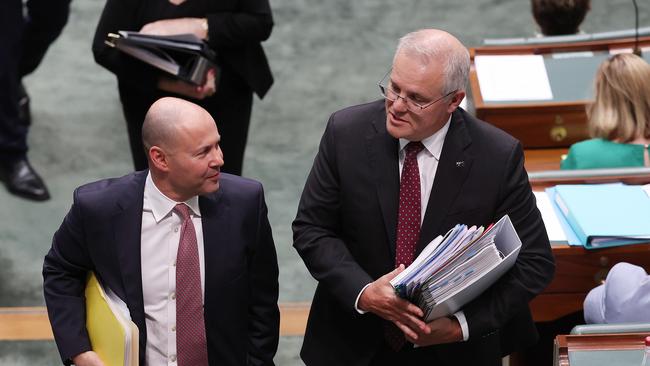Billions of reasons to doubt Treasury’s Budget forecasts
Treasury's yawning lack of self-awareness makes prime ministerial twerps Malcolm and Kevin look positively introspective.

This is the fundamental policy and even ideological underpinning of the Budget, spelt with a big, big-spending capital-B.
How come I don’t find that instantly and persuasively comforting and convincing, even coming from a Treasurer in a supposedly small-government party dedicated to leaving your money in your hands, as you are the better judge of its spending?
Aged care? Did someone say $10bn? Heck let’s make it $18bn. Infrastructure? How does $15bn sound, for starters? Then there’s $13bn on disability; $4bn on women — the mindless Treasury exactitude said $3.4bn; trust me, it will be $4bn and indeed billions higher — $2bn on childcare.
After that you get down to the “a billion here, a billion there, you’re no longer talking real money” territory; with apologies to the brilliantly named senator Everett McKinley Dirksen, who would be turning in his grave, if he hadn’t already long since spun himself right out of it with the even bigger spending in his own good old US of A.
All-up Josh Frydenberg laid out $68bn of new spending. But let me make the really fundamental point that was certainly not spelt out in the budget and not in the media reporting either.
That’s $68bn over the forward estimates out to 2024-25. It doesn’t then end; we don’t suddenly go back to the lower spending levels of before that; no, the extra spending is baked into future budgets forever.
Indeed, the $68bn is the very minimum added for every four years, pretty much forever; baked in as the base, on which you get slippage and expansion.
We know the net debt is heading for — at least and only for starters — $1 trillion; but the annual, every-year spending will be following.
This JobKeeper-boosted, supposedly one-off year it’s $661bn — or $25,000 for every Australian. Yes, it falls next fiscal year, but it will grow right back by 2025-26, and keep rising.
The second big overarching feature of the budget’s presentation and, worse, the discussion was a seeming acceptance of the credibility and even “accuracy” of the numbers out to 2024-25 and, even more ludicrously, out to 2031-32.
No, they are just very dodgy fiscal forecasts based on a, first, whole range of very dodgy and simply unrealistic economic forecasts from a hopeless and utterly discredited Treasury; and, second, the assumption that governments won’t initiate a penny of new spending over the next four years and indeed the next 10.
Just let that double expression of utter cluelessness sink in; such yawning lack of self-awareness that it makes our duo of twittering prime ministerial twerps, Malcolm and Kevin, look like the very models of introspection and self-learning in comparison.
In a budget that reveals — nay, that celebrates — getting a forecast made nearly six months into the current fiscal year — some $37bn wrong; this same Treasury purports to tell us what the deficit will be next year, in four years’ time, and indeed in 10 years’ time, down to the usual utterly inane decimal points.
Let me whisper quietly into the collective treasury ear: the deficit in 2024-25 will not, repeat not, be the $57bn you projected on Tuesday. Indeed, this year’s deficit, with just one month to go, won’t be the predicted $161bn.
Then secondly, in the very budget that reveals — indeed celebrates — the new spending of (at least: again, it will be more, perhaps much more) $68bn over the next four years, all the numbers are built on the assumption that there won’t be a penny more of new spending, for the next four and indeed 10 years.
The really telling story in the budget is how it exposes a Treasury that has shown itself utterly incapable of understanding what is happening in the economy right now in real time, far less having anything meaningful to say about next year, four years hence, far less 10 years out.
On just exactly what basis should we regard the deficit figures for the coming year 2021-22 and the three subsequent years in the official budget numbers as robust and more credible than December’s $198bn proved to be so abysmally inaccurate?
Treasury got two things wrong: the iron ore price — in effect, what was happening in the global economy — and what was happening in the domestic economy.
In December, Treasury forecast the iron ore price would be back to $US55 a tonne by now. It went of course to $US200 and higher. That’s poured an “unexpected” few billions into the budget.
In December, Treasury forecast GDP growth of 0.75 per cent in 2020-21 — at least it upped its forecast into the positive after in the formal budget, just two months earlier, predicting GDP would fall 1.5 per cent.
In December, Treasury also forecast the jobless rate would be 7.25 per cent in this June quarter.
On Tuesday, Treasury “adjusted” those forecasts to GDP growth of 1.25 per cent and a June quarter jobless rate of 5.5 per cent. No, nothing happened to suddenly make the global and local economies bloom; no, Treasury simply just didn’t have a clue what was happening. And it wants you to believe it can look clearly and reliably into the future?
And yet, everyone seems to be taking the forecast deficit out to 2024-25 and indeed 2031-32 as some sort of substantive reality; along with the “virus is dead and buried, the economic sun will keep shining endlessly” on which they are based.
The idea that we will be on the verge of a budget surplus by 2031-32 is utter fantasy. Treasury says the deficit will be down to about $40bn-$50bn. They guess, wrong; I wish. I repeat what I wrote a year ago: we will never again see a federal budget surplus.
The important, telling (economic) news of the week actually came out of the Pacific — that “shock” 4.2 per cent US inflation figure.
It’s the real future coming at us; we are as prepared for it as we’ve been for China.




“I’m from the government and I’m here to help you.”